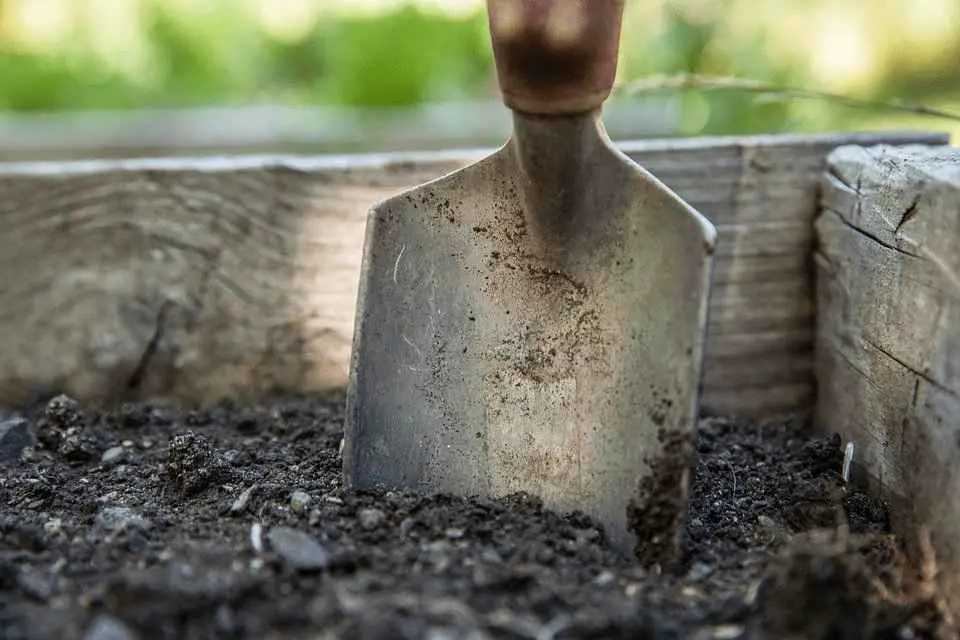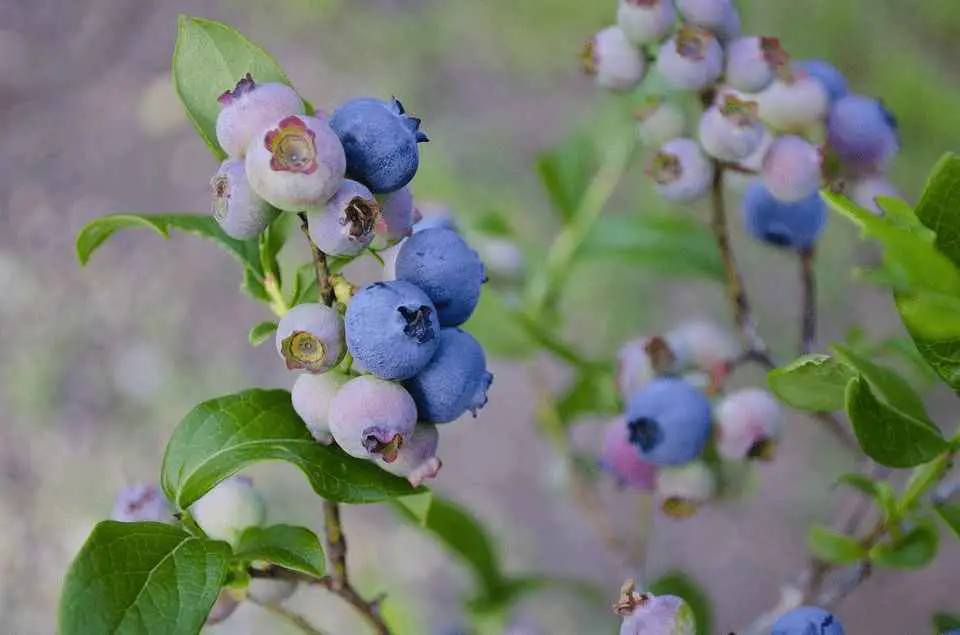A thriving blueberry bush starts with good soil. What is the best soil for growing blueberries? Unless you start with the optimal conditions, you can’t expect a healthy bush, loaded with berries, in the next few years. Continue reading, and you’ll learn all about the soil requirements of your blueberry bush and tips on preparing your garden for growing them.
Blueberry bushes don’t just keep your fridge loaded with fresh, juicy, organic blueberries but also make a beautiful addition to your outdoor landscape. A single blueberry plant can bring you about 13 to 18 pounds of fruit each season, once it’s mature, which is plenty to enjoy for a small family. And since you’ll be planting them in a pair to ensure good pollination, it also means double the harvest for a few pint jars of blueberry jam you can enjoy all year!
Reader Poll: What online courses would interest you?

What Does A Blueberry Plant Require?
Blueberry plants thrive in well-drained, loose, acidic soil that’s rich in organic matter. The ideal soil pH range for blueberry bushes is between 4.5 and 5.5, according to Michigan State University.
Usually, the garden soil isn’t perfect in its natural form for growing blueberries. You’ll need to make amendments to the soil, including lowering the pH and fertilizing it, to adjust the conditions to meet your blueberry plant’s requirements. It is worth the extra effort to make sure you have the right soil for growing blueberries.
Subscribe to our newsletter!
Site Selection
You’ve already learned in detail the kind of soil that suits blueberries best. However, besides the soil, there are other factors too, that go into picking the best location for a blueberry bush. Blueberries produce best in full sun. they’ll grow in partial shade too, but the yield may suffer.
Though blueberries are self-pollinating, you’ll get a bigger crop if they get a chance to cross-pollinate. For cross-pollination, you can plant 2 to 3 different types of blueberries with the same bloom time closeby.
Problems Resulting From Higher PH
If the pH is higher than 5, the blueberry bush won’t grow to its best potential. Their growth may slow down, and leaves will discolor. Iron chlorosis may result in blueberry plants growing in soil with higher pH. Symptoms appear on young leaves, turning them yellow with green veins. Eventually, the plants may even die if they continue growing in neutral or alkaline soil. Don’t worry all is not lost you can still make amendments to get the best soil for growing blueberries.
Soil Test For Blueberries

As soon as you plan on growing blueberries, the first thing you need to do is to get your soil tested. Take dry soil samples from the location where you plan on planting the bush. It’s best to dig holes and take several samples from beneath the topsoil. Mix the samples well and send a pint of the mix, in a clean container, to a soil analysis lab or a local cooperative extension for testing. You can also use test kits for pH available at garden centers. Doing this in advance or at least once a year will help you get the best soil for growing blueberries.
Once you get the results of your garden soil, you’ll know its exact pH together with plenty of additional useful information, like nutrient concentrations. If you have it tested at the local extension office, they’ll also tell you how to adjust your soil’s pH, if required.
Adjusting The Soil PH

Changing the soil pH can be a time-consuming process. It can take over six months to get the right pH after you’ve added the amendments. If the soil pH is greater than 6.0 or you have heavy clayey soil in your garden, the easier option is to plant blueberry in a pot. A 50-50 blend of potting soil and peat moss works perfectly for a potted blueberry plant.
Sulfur
Sulfur is the most popular acidic amendment to lower the pH of the site. Elemental sulfur is incorporated into the top 6 to 8 inches of soil the fall before planting. Allow several months for the element to react and lower the soil’s pH before you plant blueberry. It’s readily available at most garden stores. Use the instructions on the package and the results of your soil test to figure out how much to apply. Getting the pH level correct is the best way to maintain soil for growing blueberries.
Sphagnum Peat Moss
For faster results, you can also create an acidic medium with sphagnum peat and plant into it. Dig out the top 6 to 8 inches of soil from the location you plan to grow blueberries. Mix 4 to 6 inches of sphagnum peat into part of the soil you dug. Fill the hole back with this mix. Keep in mind that the roots will grow as the plant reaches maturity. So amending only the planting hole for the young plant isn’t a good idea. Amend a width of at least 2 to 3 feet to ensure roots have plenty of acidic soil around them to grow into as they expand.
Pre-Mixed Soil Amendments
Commercially available soil amendments for acid-loving plants are also a good option. Other than lowering the pH of the soil, they also nourish the soil so that the blueberry plants get all the nutrients they need for growth. The ingredients of these pre-prepared mixes include cottonseed meal, alfalfa meal, fishbone meal, feather meal, and potassium sulfate. You’ll find these amendments labeled under mixes for azaleas, rhododendrons, and camellias, which are also acid-loving plants just like blueberries. You will also find specialist soil for growing blueberries.
Mature compost soil mixtures are also great for adjusting the pH and fertilizing the soil for pH. Finished compost won’t work for blueberries since it has a neutral pH.
Planting Blueberries
The best time to plant blueberries is between early to mid spring.
- When you get the blueberry plant, either plant it immediately, or keep the roots cool and moist until they are ready to go in the ground. You can store the plant in the refrigerator or another cool place.
- When the plant is ready for planting, take it out of the fridge and unpack it. Soak the roots in water for 3 to 6 hours just before planting.
- Prune any damaged roots.
- Dig a hole that’s wide enough to hold the blueberry roots. If you’ll have multiple blueberry bushes, plant each one 4 to 6 feet apart.
- Place the plant in th hole, spreading out the roots evenly in all directions.
- Backfill the hole with soil mixed with amendments. Remember not to tap the soil down. Loose soil is good for blueberries.
- Water the soil just after planting.
Mulching

Once you’ve prepared an acidic, fertile soil and planted your blueberry, mulching the soil for growing blueberries with the right material helps maintain an acidic environment and promote growth. Acidic mulches, such as sawdust or bark, work well for blueberries, keeping the soil moist and cool and increasing its nutrient content and acidity over time. Since healthy blueberry bushes can survive over 20 years, maintain a few inches of mulch around them throughout their lifetime.
Blueberry Care
Other than giving them the ideal soil, blueberries need some ongoing care through the growing seasons to keep them producing optimally. Here are some useful tips:
- Blueberries have little or no root hair. That’s what makes them more sensitive to moisture fluctuations in the soil than other crops. They will typically need 1” of water per week during the growing season, and 4” per week during fruit ripening. Lack of water may lead to smaller fruit. Keep the soil moist, but not soggy. Use a low pH mulch, such as pine needles or peat moss to cover the soil around the plant and conserve its moisture.
- Blueberries don’t compete well with weeds. Weed often to keep the soil around the blueberries weed-free. However, avoid cultivating the soil around the bushes since blueberries are shallow-rooted. Instead, pull out the weeds by hand to avoid damage to the blueberry roots around it.
- New blueberry plants will need to be fertilized in early spring before they put on new growth, and again in late spring when the growth is at its peak. Established blueberries will only need to be fed once a year. Acid fertilizers, such as those for rhododendrons and azaleas, work best for blueberries.
- Established blueberry bushes need to be pruned during the dormant season to remove old canes, inward painting canes, damaged and diseased canes to keep the new canes producing optimally.
Conclusion
Once you’ve prepared a good garden bed for your blueberries at a sunny spot and maintained it well, the bushes will thrive and give you nutritious, delicious fruits each season in the coming years. The right soil for growing blueberries is so important because without the nutrients and acidic levels your blueberry bush won’t thrive.

